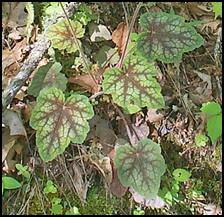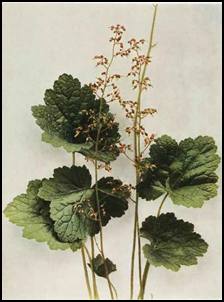You entered Alum, the more common name is...

Alumroot
SCIENTIFIC NAME:(Heuchera americana)
Native to Central U.S, this small evergreen perennial with its green, purple, or brown leaves that are often veined or marbled rarely reaches 2 feet in height or width. Greenish or cream colored flowers appear on 3 foot stalks in early summer.
Common Names:
Alum

Uses:
A tea made from the roots will aid with digestive issues, gastric problems and nausea. Use a poultice made from the roots to stop bleeding, wounds, reduce swelling of moist tissues and reduce inflammation. Drink tea made from leaves of the plant when treating diarrhea or dysentery, and for a sore throat, leaf tea makes a great gargle.Applications:
Tea:
Tea brewed from roots or leaves; drink 1 to 3 cups a day.
Poultice:
Use roots when making the poultice and apply to inflicted area.
Warnings:
Do not exceed 20 grams of powdered root. Excessive use may cause gastric irritation, kidney or liver failure.
With any herb, there is the risk of an allergic reaction. Small children and pregnant women should use additional caution when considering the use of herbal remedies.





